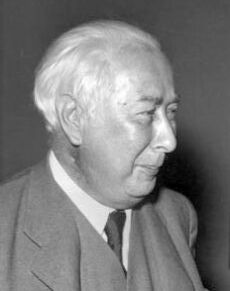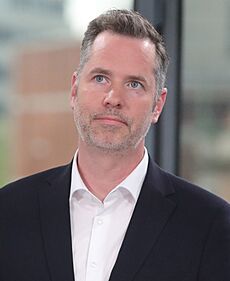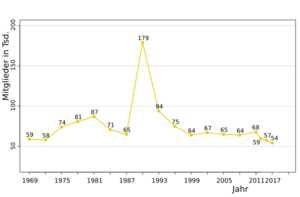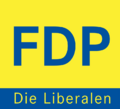Free Democratic Party (Germany) facts for kids
Quick facts for kids <div style="padding-top:0.3em; padding-bottom:0.3em; border-top:2px solid Lua error in Module:European_and_national_party_data/config at line 227: attempt to index field 'data' (a nil value).; border-bottom:2px solid Lua error in Module:European_and_national_party_data/config at line 227: attempt to index field 'data' (a nil value).; line-height: 1;">
Free Democratic Party
Freie Demokratische Partei
|
|
|---|---|
 |
|
| Abbreviation | FDP |
| Leader | Christian Dürr |
| General Secretary | Nicole Büttner |
| Founded | 12 December 1948 |
| Merger of |
|
| Headquarters | Hans-Dietrich-Genscher-Haus Reinhardtstraße 14 10117 Berlin |
| Newspaper | fdplus |
| Youth wing | Young Liberals |
| Women's wing | Liberal Women |
| University wing | Federal Associations of Liberal College Groups |
| Foundation | Friedrich Naumann Foundation |
| Membership (November 2024) | |
| Ideology | Liberalism (German) |
| Political position | Centre-right |
| European affiliation | Alliance of Liberals and Democrats for Europe |
| International affiliation | Liberal International |
| European Parliament group | Renew Europe |
| Colours |
|
| Bundestag | Lua error in Module:European_and_national_party_data/config at line 227: attempt to index field 'data' (a nil value). |
| European Parliament | Lua error in Module:European_and_national_party_data/config at line 227: attempt to index field 'data' (a nil value). |
| State Parliaments |
65 / 1,891
|
| Party flag | |
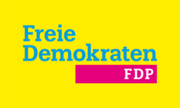 |
|
| Website | |
| Lua error in Module:European_and_national_party_data/config at line 227: attempt to index field 'data' (a nil value). | |
The Free Democratic Party (in German: Freie Demokratische Partei), or FDP, is a liberal political party in Germany. Liberalism is a belief that focuses on individual freedom. The FDP was founded in 1948 by members of older liberal parties that existed before World War II.
For many years, the FDP was an important party in the Bundestag, Germany's parliament. It was often the junior partner in a coalition government. This means it governed alongside a larger party. The FDP worked with both the centre-right CDU/CSU and the centre-left SPD.
In the 2013 federal election, the FDP did not get enough votes to enter the Bundestag. It was the first time the party had no seats in the parliament. They returned to the Bundestag after the 2017 election. From 2021 to 2024, the FDP was part of a "traffic light coalition" government with the SPD and the Greens.
In the 2025 federal election, the party again did not get enough votes to enter the Bundestag.
Contents
History
How the FDP Began
The idea of liberal parties in Germany goes back to the 1800s. Before World War II, there were two main liberal parties. After the war, many liberals wanted to unite these two groups into one party.
After the war, Germany was divided into occupation zones. In the Soviet zone in East Germany, the Liberal-Democratic Party (LDP) was formed in 1945. In the Western zones, other liberal groups also started. They all wanted to create a single, united liberal party for all of Germany.
On December 12, 1948, these liberal groups met in the town of Heppenheim. They officially created the Free Democratic Party (FDP). Theodor Heuss became the party's first chairman. The location was special because an important meeting of liberals had happened there in 1847.
Early Years in Government (1949–1969)

In the first West German election in 1949, the FDP won 11.9% of the vote. They formed a government with the CDU/CSU party. The FDP's leader, Theodor Heuss, was elected as the first President of West Germany.
The FDP supported a social market economy, which mixes free markets with social policies. In the 1950s, the party had some internal disagreements. Some members had more nationalist views, which caused problems. The party worked to move past these issues and focus on its liberal ideas.
In 1956, the FDP left the government and became an opposition party. But in the 1961 election, they did very well, winning 12.8% of the vote. They rejoined the government with the CDU/CSU. From 1966 to 1969, the FDP was the main opposition party in the Bundestag.
A New Direction (1969–1982)
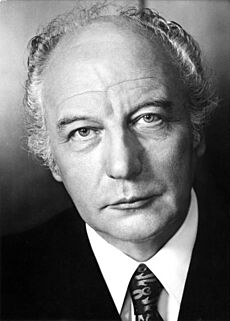
In the 1969 election, the FDP decided to form a coalition with the centre-left SPD. This was a big change. The new government was led by Chancellor Willy Brandt (SPD), with FDP leader Walter Scheel as Vice Chancellor and Foreign Minister.
This government was known for its Ostpolitik. This policy aimed to improve relations with East Germany and other communist countries in Eastern Europe. This was a controversial but important step.
In 1974, Walter Scheel became the second FDP member to be elected President of Germany. Hans-Dietrich Genscher took over as the new FDP leader. He continued the coalition with the SPD under Chancellor Helmut Schmidt.
The Kohl Era and Reunification (1982–1998)
In 1982, the FDP changed its coalition partner again. They left the government with the SPD and joined the CDU/CSU. This made Helmut Kohl (CDU) the new chancellor. This change, known as die Wende (the turn), caused some members to leave the FDP.
The FDP remained in government with Helmut Kohl for 16 years. During this time, Hans-Dietrich Genscher was the Foreign Minister and a very popular politician.
When the Berlin Wall fell in 1989, the FDP played a role in German reunification. Liberal parties in East Germany joined with the FDP. In the first all-German election in 1990, the FDP got 11% of the vote, a strong result. The party stayed in government until 1998.
Recent History (2000–Present)
After 1998, the FDP was in the opposition. In 2009, under leader Guido Westerwelle, the party achieved its best-ever result with 14.6% of the vote. They formed a new government with the CDU/CSU, led by Chancellor Angela Merkel.
However, the party's popularity soon fell. In the 2013 election, the FDP received only 4.8% of the vote. This was not enough to meet the 5% minimum needed to enter parliament. For the first time, the FDP had no seats in the Bundestag.
Christian Lindner became the new party leader. Under his leadership, the FDP worked to rebuild its support. In the 2017 election, they succeeded, winning 10.7% of the vote and returning to the Bundestag.
After the 2021 election, the FDP joined a "traffic light coalition" with the SPD and the Greens. The party controlled important government departments, including the Ministry of Finance. This government ended in November 2024. In the 2025 snap election, the FDP again failed to get enough votes and lost all its seats in the Bundestag.
What the FDP Believes In
The FDP's main belief is liberalism. This means they focus on individual freedom, human rights, and a free-market economy.
Key ideas of the FDP include:
- Economic Freedom: The party supports lower taxes and less government spending. They believe that businesses should have the freedom to grow with fewer rules. This is often called economic liberalism.
- Individual Rights: The FDP strongly defends civil liberties. This includes things like freedom of speech and the right to privacy. They are often against too much government surveillance.
- Education: They believe in investing in education to give everyone a chance to succeed.
- Digitalization: The FDP wants to improve Germany's internet and technology infrastructure.
- Europe: The party is generally pro-European. They support the European Union but also want to reform it to make it more efficient and democratic.
The FDP is usually seen as a centre-right party because of its economic ideas. However, on social issues like civil rights, it is often closer to centre-left parties.
Who Votes for the FDP?
The FDP's voters often include self-employed people, business owners, and professionals like doctors and lawyers. The party does not have a large, fixed group of voters like some other parties. This means its election results can change a lot.
In recent years, the FDP has become very popular with young voters. In the 2021 election, it was the second most popular party among voters under 30. These younger voters are often attracted to the party's focus on individual freedom, education, and modern technology.
Images for kids
-
Hans-Dietrich Genscher was Foreign Minister for almost 20 years, from 1974 to 1992.
-
Guido Westerwelle (right) with his partner in 2009. Westerwelle led the party to its best-ever election result.
-
Alexander Graf Lambsdorff was a Vice President of the European Parliament.
See also
 In Spanish: Partido Democrático Libre para niños
In Spanish: Partido Democrático Libre para niños


